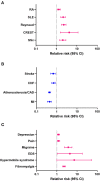Sex differences in comorbidities associated with Sjögren's disease
- PMID: 35991633
- PMCID: PMC9387724
- DOI: 10.3389/fmed.2022.958670
Sex differences in comorbidities associated with Sjögren's disease
Abstract
Background: Little is known about the association of comorbidities with sex and age at diagnosis in Sjögren's disease. We tested the hypothesis that sex differences occur in comorbidities in patients with Sjögren's disease.
Methods: Patients with Sjögren's disease were identified from 11/1974 to 7/2018 in the Mayo Clinic electronic medical record and assessed for 22 comorbidities according to sex and age at diagnosis.
Results: Of the 13,849 patients identified with Sjögren's disease, 11,969 (86%) were women and 1,880 (14%) men, primarily white (88%) with a sex ratio of 6.4:1 women to men. The mean age at diagnosis was 57 years for women and 59.7 years for men, and 5.6% had a diagnosis of fibromyalgia at Sjögren's diagnosis. Men with Sjögren's disease were more likely than women to be a current or past smoker. The average time to diagnosis of comorbidities after diagnosis of Sjögren's disease was 2.6 years. The top comorbidities in patients with Sjögren's disease were fibromyalgia (25%), depression (21.2%) and pain (16.4%). Comorbidities that occurred more often in women were hypermobile syndromes (31:1), CREST (29:1), migraine (23:1), Ehlers-Danlos syndrome (EDS) (22:1), Raynaud's syndrome (15:1), SLE (13:1), systemic sclerosis (SSc) (13:1), and fibromyalgia (12:1). Women with Sjögren's disease were at increased risk of developing hypermobile syndromes (RR 7.27, CI 1.00-52.71, p = 0.05), EDS (RR 4.43, CI 1.08-18.14, p = 0.039), CREST (RR 4.24, CI 1.56-11.50, p = 0.005), migraine (RR 3.67, CI 2.39-5.62, p < 0.001), fibromyalgia (RR 2.26, CI 1.92-2.66, p < 0.001), Raynaud's syndrome (RR 2.29, CI 1.77-2.96, p < 0.001), SLE (RR 2.13, CI 1.64-2.76, p < 0.001), and SSc (RR 2.05 CI 1.44-2.92; p < 0.001). In contrast, men with Sjögren's were at increased risk for developing myocardial infarction (RR 0.44, CI 0.35-0.55, p < 0.001), atherosclerosis/CAD (RR 0.44, CI 0.39-0.49, p < 0.001), cardiomyopathy (RR 0.63, CI 0.46-0.86, p = 0.003), stroke (RR 0.66 CI 0.51-0.85, p = 0.001), and congestive heart failure (RR 0.70, CI 0.57-0.85, p < 0.001).
Conclusions: The top comorbidities in Sjögren's disease were fibromyalgia, depression, and pain. Women with Sjögren's disease had a higher relative risk of developing fibromyalgia, depression, pain, migraine, hypermobile syndrome, EDS and other rheumatic autoimmune diseases. Men with Sjögren's disease had higher risk of developing cardiovascular diseases.
Keywords: Ehlers-Danlos syndrome; atherosclerosis; depression; fibromyalgia; hypermobile syndrome; migraine; pain; smoking.
Copyright © 2022 Bruno, Morales-Lara, Bittencourt, Siddiqui, Bommarito, Patel, Sousou, Salomon, Paloka, Watford, Hodge, Lieberman, Rozen, Atwal, Dorsher, Seim and Fairweather.
Conflict of interest statement
The authors declare that the research was conducted in the absence of any commercial or financial relationships that could be construed as a potential conflict of interest.
Figures
References
-
- Setoodeh K, Wallace D. Who develops Sjögren's? In: Wallace D. editor. The Sjögren's Book. New York, NY: Oxford University Press. (2012). p. 11–4.
Grants and funding
LinkOut - more resources
Full Text Sources
Miscellaneous


